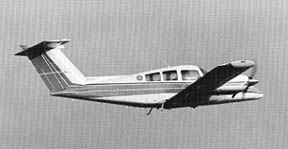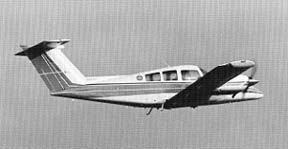
Mix a beautiful late spring evening, a nicely kept light twin and a couple of flying friends and youll have a recipe that makes most pilots salivate at the possibilities. Though flying is often about transportation or a paycheck, Id bet most pilots say the enjoyment of flight is what started them down that airway – at least in the beginning.
Idyllic weather over picturesque scenery creates a thing of beauty no poet can conquer and no painter can put to shame. Flying in those conditions has inspired many to take the road less traveled, but on rare occasions those inspired have been moved to follow a dangerous course on which the goal was lofty but the risk alarming.
Such was the case in May 2001 when two friends rented a Beech Duchess belonging to their employer, a Denver area flight school. They had attended college together and their day planners revealed they had scheduled a number of flights together – including the day before.
Sitting in the left seat was a 31-year-old who had accumulated just over 850 hours since learning to fly five and a half years earlier. He had 82.3 hours of multi-engine time, most of it in Duchesses, and had gotten his multi-engine rating four months earlier.
To his right was a 30-year-old with 1,026 hours since learning to fly in early 1994. He had gotten his multi-engine rating a year and a half earlier but had logged only 43.5 hours, 10.4 of which was in the Duchess and 2.4 apparently had been logged the previous day.
The two boarded the blue-and-white airplane and departed Centennial Airport just before 6 p.m. The airplane was flying VFR and without a flight plan. There was no record of either pilot getting a weather briefing that would indicate any particular destination. But each had instructed students that day, and the weather was clear skies with 10 miles visibility, so the lack of a weather briefing for a local flight was understandable.
Radar data showed the airplane climbed to a mode C-reported 9,800 feet and flew southwest until it flew out of radar coverage 20 miles from the airport.
The airplanes route as it crossed the Rocky Mountains is uncertain. But about an hour after the takeoff a resident of the small town of Crested Butte reported a small twin flying low over town and disappearing to the south. Low-altitude airway V-421 runs south from Crested Butte to Gunnison, following the 353 radial off of the Gunnison VOR. However, if the next witness to come forward about the airplane is to be believed, V-421 had nothing to do with the airplanes route.
Some 20 miles to the south, a resident of Gunnison reported seeing an airplane matching the description of the Duchess flying south over the Gunnison River at a high speed. He said the airplane was below the crest of the Palisades bluffs and was flying at 200 feet above ground level or less. About a mile south of the witness home, the airplane abruptly made a steep-banked turn to the west and followed the river to the west as it made its way to the Blue Mesa Reservoir.
The witness thought the pilot might be making some kind of unconventional approach to runway 6 at Gunnison County Airport, so he went inside and turned on a radio to monitor the Gunnison Unicom frequency. He heard no transmissions, so after a few minutes he turned the radio off.
The fixed base operator at the Gunnison airport was waiting outside for a UPS truck when he spotted the airplane flying south at the same 150 to 200 feet the other witness reported. The airplane banked right and followed the river west. He went inside and heard a broadcast on the Unicom frequency in which two people were discussing the shoreline and different fingers of water on the reservoir. He concluded the airplane had a stuck microphone switch.
A woman who was towing her boat from the Blue Mesa Reservoir back to Gunnison reported that she was driving along the highway that ran alongside the river when a twin-engine airplane suddenly appeared around a corner, coming straight at her at about 50 feet agl. At first she was afraid the airplane would land on the road directly in front of her, but it showed no signs of trouble and the engines sounded strong and it passed over her truck.
On either side of the airplanes route, terrain soared. Fifteen miles to the right, the West Elk Wilderness Area had peaks that climbed to over 13,000 feet. Twenty miles to the left, Uncompahgre Peak rose to more than 14,300 feet. The water level below the airplane was about 7,500 feet msl.
A U.S. National Park Service ranger at the east end of the reservoir saw the airplane buzz low over the water, close enough to the surface for the propellers to kick up spray. Then, in full view of numerous witnesses enjoying the close of a day of boating, the airplane struck a set of power lines that crossed the water.
The airplane struck the four, half-inch diameter high-tension lines at what was later calculated to be 250 feet above the water. It nose-dived into the water. A fuel-fed fire burned on top of the water for a few minutes. Several boats immediately went to the scene, but no survivors surfaced.
Small pieces of debris, including a logbook, a backpack and some aircraft documents, floated to the surface, but the bulk of the wreckage sank in 130 feet of water.
The Aftermath
Five days later, side-scanning sonar located the wreckage in the reservoir. It took another five days to begin recovery operations, and the wreckage was raised on May 23 – 12 days after the accident.
When autopsies were performed on the two pilots, the pathologist noted a piece of paper clenched in the left-seat pilots fist. It was later identified as part of the Denver sectional chart. The pathologist further concluded that the injuries of the right-seat pilot were consistent with being at the controls at the time of impact, while the injuries of the left-seat pilot were not.
The pathologist detected another error in judgment by one of the pilots: The right-seat pilot also tested positive for marijuana use.
During such a buzzing incident, the concept of see-and-avoid seems somewhat obvious in retrospect. Whether the airplane belonged there is moot at this point. The question becomes whether the wires should have been visible.
FAA Advisory Circular 70/7460-1K, which addresses marking of obstructions, suggests that power lines carrying more than 69,000 volts should have lighted markers for increased visibility at night. However, three of the lines the Duchess hit were carrying only 26,000 volts and the fourth only 12,000 volts. The advisory circular further states that markers should be used on wires that are near airports, heliports, across rivers, canyons, lakes, etc.
In addition, regulations defining what constitutes objects interfering with navigable airspace specify that only objects that rise to more than 500 feet agl or 300 feet agl within three miles of an airport should be considered hazards.
Furthermore, Part 91 regulations advise pilots to stay 500 feet away from the surface or any person, vessel or structure.
Finally, a Colorado state statute prohibits operation of an aircraft within 10 feet of a high-voltage overhead power line. Even that one was busted in this accident.
The power lines in question were strung across a narrow part of the reservoir. On each side of the water, 40-foot-tall towers were installed on terrain that was about 230 feet above the water. The poles were about 1,245 feet apart.
So unmarked wires and a low flying airplane combined to lead to tragedy. But was it a mistake or a serious lapse by one or both of the pilots involved? The answer is chilling.
The flight school that employed the pilots said the right-seat pilot, who was determined to have been at the controls at the time of impact, had been flying with another instructor in a privately owned Beech Baron a few days earlier. That instructor, who was PIC for the flight, said the right-seat pilot suggested they turn toward Blue Mesa Reservoir. Once there, he said, they could indulge in some low-level flying.
The pilot in command of the Baron wisely declined.
Also With This Article
Click here to view the accident map.
-by Ken Ibold




